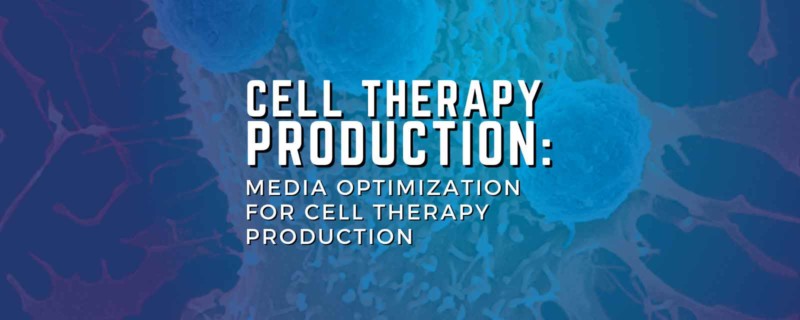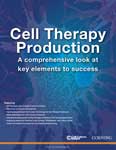
Media Optimization for Cell Therapy Production
 This article was originally published in the eBook
This article was originally published in the eBook“Cell Therapy Production”.
You can download all the articles in the series, by downloading the eBook.
In cell-based therapies, the cultured cells are the therapeutic product, which necessitates different manufacturing processes as compared with other biologics productions. As a cell therapy developer, the big considerations in the scale-up process include the input cells, culture vessels, and culture media. Inadequate consideration and planning can not only impact the efficacy of the cell therapy, but also present costly regulatory roadblocks that can delay progress through the product pipeline. Since the culture media is linked to the growth and productivity of the cells, it is one of the most critical aspects of process development during scale-up.
While off-the-shelf media solutions can provide a fast and efficient solution in early development, there are some specific scale-up conditions that are difficult to meet with off-the-shelf media. Moving from small-scale, small volume static cultures to large- scale, large volume vessels trigger a host of additional requirements that cannot be easily addressed with an off-the- shelf solution. Thus, media customization by a media manufacturer is an attractive solution to the increased considerations associated with large scale; these include media stability, packaging, handling and storage, and de-risking the overall process.
Here, we look at media development and customization to provide insight into the cell culture media scale-up process. We also examine how partnering with a contract media manufacturer can provide the additional experience and support needed for a successful transition from lab to commercial scale cell therapy production.
Media Stability
Media stability can present a challenge; particularly since most media formulations used to culture specialized cell types used in cell therapies are complex. These formulations frequently contain raw material components like growth factors that can lose efficacy over time and stability must be carefully considered. In addition, during the scale-up process, the use of large culture vessels necessitates a larger volume of media and cell therapy developers may want to ensure consistency in their process by only using one lot of cell culture media for an entire production run. So, the capacity to store and manage a large inventory of cell culture media while maintaining shelf life and stability is critical. For this reason, it is important to consider batch size, storage conditions, capacity, and media availability, i.e. order to delivery times when planning process scale-up. For certain therapies like autologous CAR-T where the vein-to-vein time from collection to manufacturing to re-infusion is very short, not having enough media on-hand for production can be disastrous.
As mentioned, the raw materials themselves can impact media stability. Working with a media provider can provide the support to potentially adjust your media formulation, identifying substitutions or more consistent cGMP-grade reagents that could improve stability.
Media Packaging
Large-scale manufacturing requires the use of automated and aseptic, closed processes. During scale-up when a process moves from open to closed, bottled media is not a desirable format because of the complexity and inherent aseptic risk with handling many bottles. Therefore, moving to bagged media systems is a common transition in scale-up. Related to this is the connection technology – how will the media be transferred from the bags to culture vessels while maintaining sterility in a closed system. The type of tubing used (i.e. the type of plastic and diameter) in conjunction with the bag connectors (Table 1) will also be dependent on the specifics of your process. Having a supplier that can identify and address the needs of your program can help mitigate any bottlenecks in the transition to closed system operations.
At Corning we frequently work with customers to design media packaging that accommodates different needs that may be particular to their process – bags with specific types of connections or with dip tubes to ensure they can fully empty the bag, for example.
Table 1. Common connector technologies used with bagged media formats.
| Connector Technology | Details |
|---|---|
| Open Connectors | Open connectors require a controlled environment like a BSC to make an aseptic connection with the media bag like luer fittings and MPC-type connectors. |
| Aseptic Connectors | Aseptic connectors can establish an aseptic connection regardless of the environment, which is advantageous over open connectors, but they can be difficult to operate and are more expensive |
| Tube Welding | Best for situations where only a few aseptic connections are needed because it takes time, equipment and expertise to establish a proper sterile tube weld. |
In-house vs. Outsource of Media Manufacturing
Many companies will need to make the critical decision of whether to enlist the services of a contract media manufacturer for their cell therapy needs. Current Good Manufacturing Practice (cGMP) media production is complex and is governed by strict oversight by regulatory agencies, such as the U.S. Food and Drug Administration (FDA), Health Canada, and the European Medicines Agency (EMA). Extensive validation and documentation are required in order to fulfill cGMP requirements, which is time- and labor-intensive to achieve in-house if the infrastructure and capacity are not already in place. For example, having a dedicated manufacturing suite and a suitable water system (Water for Injection (WFI)) in place for biomanufacturing are necessities for cGMP manufacture and these are costly investments.
The advantages of partnering with an outsourced manufacturing company is that the necessary infrastructure and expertise are established and available to help meet specific media needs from formulation to packaging, and regulatory requirements. Moreover, it
lowers capital costs as there is no need to invest in a WFI system, which is particularly valuable in the early stages of scale-up. As well, with years of experience in media development and commercial manufacturing and as a provider of high-quality raw materials, the components are available through one supplier making it an easy and simplified tech transfer transition for a cell therapy developer. Perhaps most valuable is the knowledge and expertise that these companies can provide because of their involvement with other customers/processes so they can make recommendations based on what has or has not worked in the past to help you meet your needs.
Regulatory Considerations
Developers need to meet current regulations for cell therapy manufacturing, and choosing a media supplier can help. For example, custom media products produced at Corning are manufactured in a facility that meets the current ISO 13485 standard and FDA Quality System Regulation 21 CRF 820, also known as current good manufacturing practices (cGMP).
Media Customization Services
It is helpful to understand what the media customization process looks like when outsourcing this development. We have used the experience of working with the team at Corning to provide insight into this process. Corning routinely works with companies to produce customized, tailored media and reagents to meet unique process needs, steps include:
1) Formulation/Batch Size
Typically, discussions between team members from both the Corning and customer side occur to determine the media formulation. Batch size determination may go together with the specific media components since their stability/shelf life may impact maximum batch size.
Serum:
For serum-containing formulations, Corning has an extensive portfolio of serum products that are collected from government approved abattoirs in the United States, Australia, and New Zealand, processed, and tested in accordance with and EP (European Pharmacopeia) and USP (United States Pharmacopeia) methods. Corning holds Certificates of Suitability (CEP) from the European Directorate for the Quality of Medicines (EDQM) for US and Australian origin serum. As well, Corning facilities are ISIA traceability certified for serum.
Animal-component or Serum-free Formulations:
As the cell and gene therapy market increases, there is a drive towards minimizing or eliminating animal components in media formulations to remove the potential immunogenic risk from xenogeneic raw materials. At Corning, custom media and sterile solutions are produced in separate designated animal and non- animal manufacturing suites. For animal component free (ACF) media production, the raw material processing is also segregated from the animal-containing manufacturing stream, which allows for certification as completely animal component free.
Corning can also provide expertise to help bring a customer formulation to animal-component free state since there are recombinant proteins available to replace more traditional animal- derived components.
2) Format
Upon scale up, the format in which the custom media is packaged is also a huge consideration and primarily dependent on the customer’s process needs, as well as handling/processing capabilities and storage capacity. Corning can accommodate different sizes of bottles as well as bags depending on the scale, from 30 mL to 1L in bottles and from 1L bags to 200L bags suitable for various connector technologies. Most commonly, 20- 200L bag formats are utilized. Above 200L sizes can be accommodated but these can be difficult to manage and store. Additionally, there is a higher risk of losing your entire batch of media if there is a bag failure as well as the associated cost of such a failure, both components and time.
3) Quality Control
All custom media undergo compendial testing according to industry standards using USP or EP monographs to ensure it meets biological (i.e., endotoxin, mycoplasma) and physiochemical requirements (i.e., pH, osmolality, conductivity). Depending on the formulation, whether it is a salt solution or a more complex cell culture media, functional testing can be performed to demonstrate that the media can support cell proliferation.
Ultimately, quality control testing that accompanies a custom media to ensure that the product is suitable for the intended process and downstream use is driven by the customer. For example, quality samples can be taken at the beginning, middle, and end of a production run to ensure manufacturing consistency. Additional stability testing of raw material components and in the final formulation may be required as well. Depending on the media formulation, confirming the correct identity and concentration of media components can be done. This will require a dialog between Corning and the developer’s quality team to identify the critical parameters for the Certificate of Analysis.
4) Small-scale Pilot batch
Once the specifications are established, a small-scale pilot batch is generated ideal for development and testing purposes prior to cGMP scale-up. Once this pilot batch has passed quality control testing and is acceptable to the customer, the final step is to manufacture a full-scale cGMP batch.
5) Large-scale cGMP batch
The overall cGMP batch sizes range from 100L to 8,000L and the options available can depend on the media formulation (Table 2).
| Media Type | Volume |
|---|---|
| Animal | 100 – 200L 1,000 – 6,000L |
| Animal-component free | 100 – 200L 400 – 2,000L 1,600 – 8,000L |
While media customization and optimization for cell therapy manufacturing can feel daunting, there are key considerations to focus on. Working with a company to help with this work can be very beneficial in that it provides vast experience across a range of products and capabilities that is difficult and costly to replicate using in-house resources. In addition, outsourcing media customization, frees valuable labor and capital resources that cell therapy developers can utilize for other aspects of the cell therapy commercialization process.